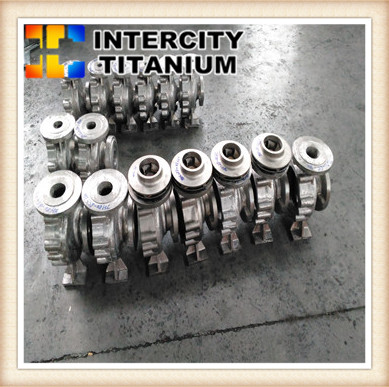Titanium casting knowledge
In a vacuum or protective atmosphere, the titanium material is melted. Cast into the casting process. Is one of the titanium material preparation process.
Titanium in the molten state is very lively. For a long time failed to find a suitable casting method and modeling materials, from the 70's after the titanium alloy large-scale thin-walled precision casting technology has been developed and applied. In its material performance close to or equal to the premise of aviation titanium forgings, the cost is reduced, by about 50%, resulting in rapid development of titanium casting technology.
Casting equipment and process Vacuum consumable arc coagulating shell furnace is the main equipment for producing titanium castings. Its principle is: in the furnace body, titanium material ingot or forging stick is used as the mother material electrode (negative electrode), and the water-cooled copper crucible serves as positive electrode , Under low pressure (25 ~ 40V), a large current is input under a vacuum atmosphere. After the two electrodes are close to arc. The molten titanium material consumes the end of the electrode and drips into the crucible to form a molten pool. Under the action of water cooling, a coagulation shell is formed between the wall of the copper crucible and the molten pool to protect the crucible from corrosion and prevent the titanium liquid from being contaminated. When the molten pool in the crucible grows to a sufficient amount, the power is reduced off, the electrode is rapidly lifted, the crucible is turned over, and the molten titanium water is injected into the standing or centrifuge mold. The advantages of the coagulation shell furnace are that the production efficiency is high and the alloy composition is well controlled. The disadvantage is the low degree of metal superheat, the need for hasty casting and equipment larger casting system.
Modeling methods Graphite casting and investment casting.
Graphite casting graphite type is the production of civil titanium casting the core modeling process. Divided into graphite and graphite processing type. Processing Graphite type is made of high-quality artificial graphite block by hand or machining, according to the complexity of the mold, you can use more live black combination, this mold can be used repeatedly. Graphite tamping type is made of artificial graphite band material and carbon organic binder after milling mixed material, in the wood mold or metal mold sand box, by hand or modeling mechanical modeling. Make a good graphite band, baked at low temperature drying and curing, covered under dry powder graphite, or in a non-oxidizing atmosphere, high temperature calcination. Make a nice combination of molds, can be installed furnace casting. Production of strict quality aviation castings, its processing and pounding type is required before the vacuum degassing treatment.
Investment casting Precision casting is the production of high precision, complex shape, smooth surface and internal dense aerospace titanium alloy casting the highest process. Investment casting method of titanium and steel casting process is basically the same, but in the shell material and some processes are different.
There are three processes used to produce titanium precision castings today:
(1) graphite shell processes.
(2) metal surfaces ceramic shell process.
(3) oxide ceramic shell process. The leading low-cost, can be used for small and medium-sized castings, the latter two can be used for the production of large-scale thin-walled precision castings.
Cast titanium alloy and casting quality Most of the deformed titanium alloy can be used for casting. The most widely used is Ti-6A1-4V alloy. Its casting performance is respectable, organizational performance and stability. Compared with the uniform deformation alloy, the strength of the cast titanium alloy is basically the same, but its plasticity and fatigue performance of about 40% to 50%, while the fracture toughness is slightly better.
Titanium material castings are generally stabilized annealed, and the solution treatment and hydrotreating in the study can refine the grains, improve the microstructure and improve the fatigue properties of the alloy to forgings. Hot isostatic pressing is a commonly used method of processing high-quality titanium castings. After high temperature and high pressure treatment, the size of the castings does not change, while the internal structure becomes more dense and the stability of the mechanical properties will be significantly improved.









